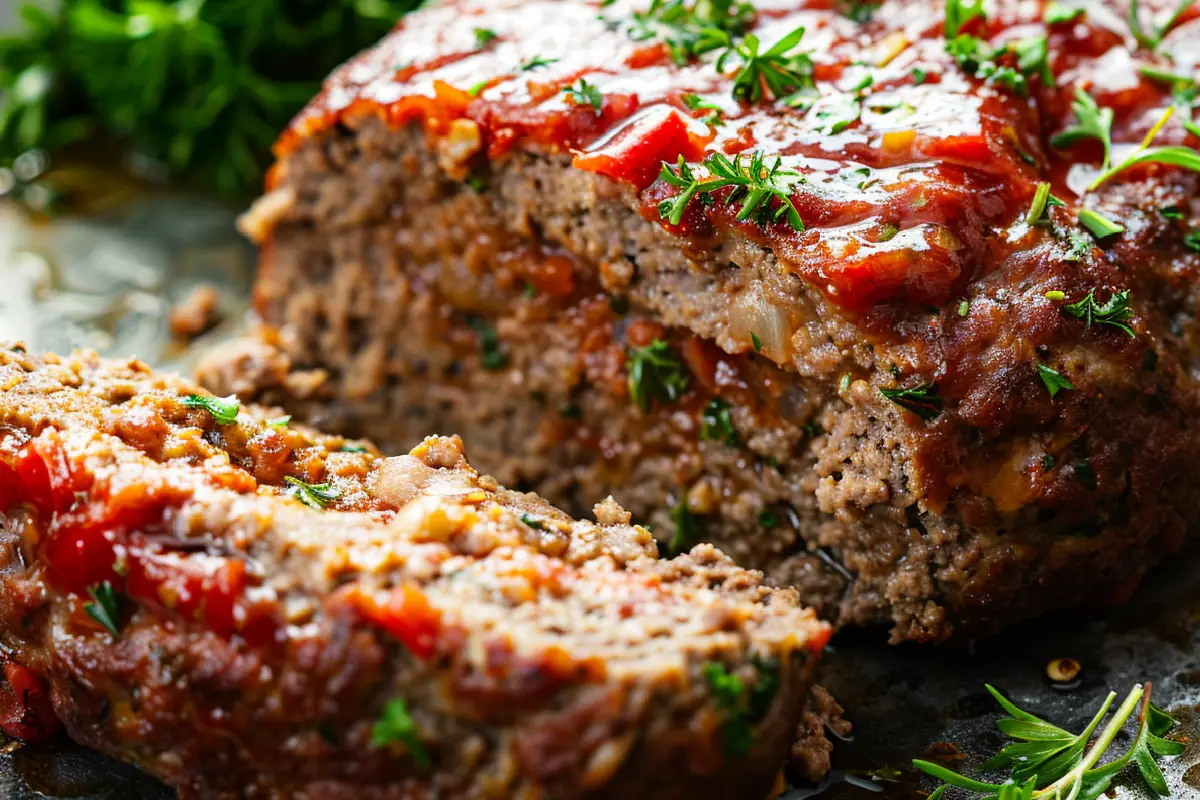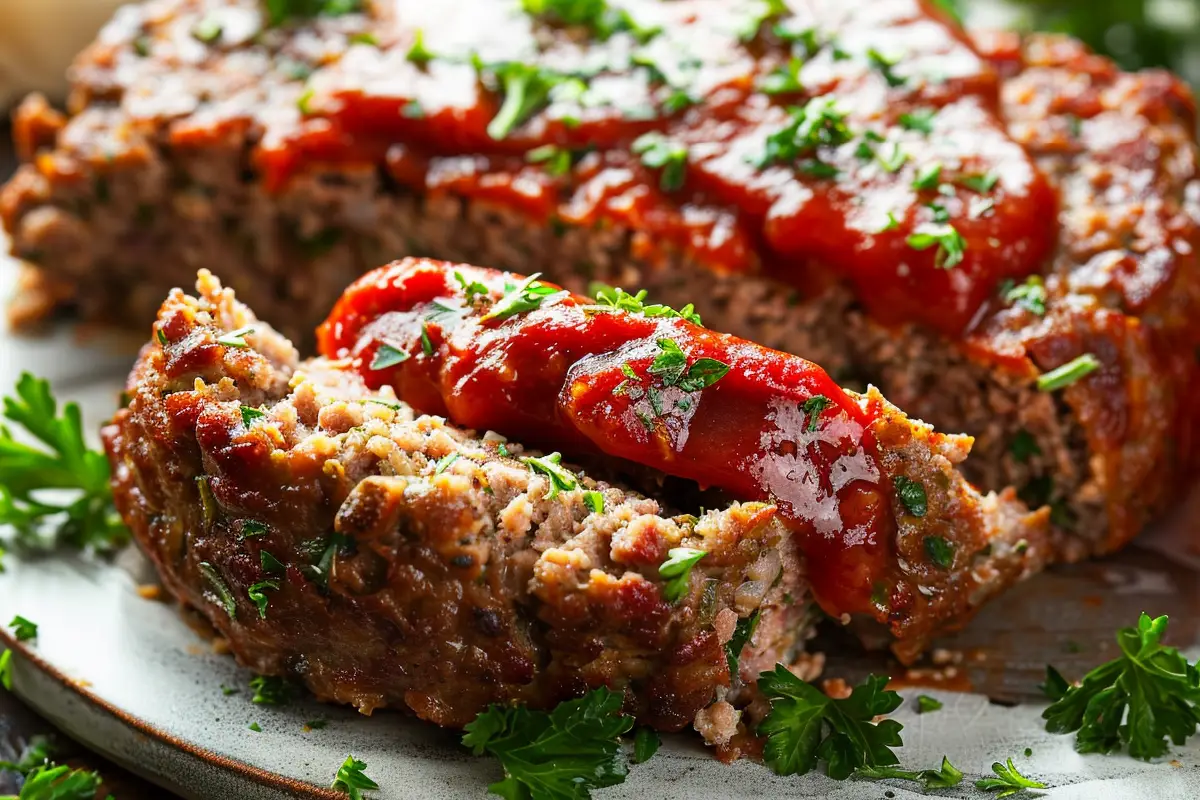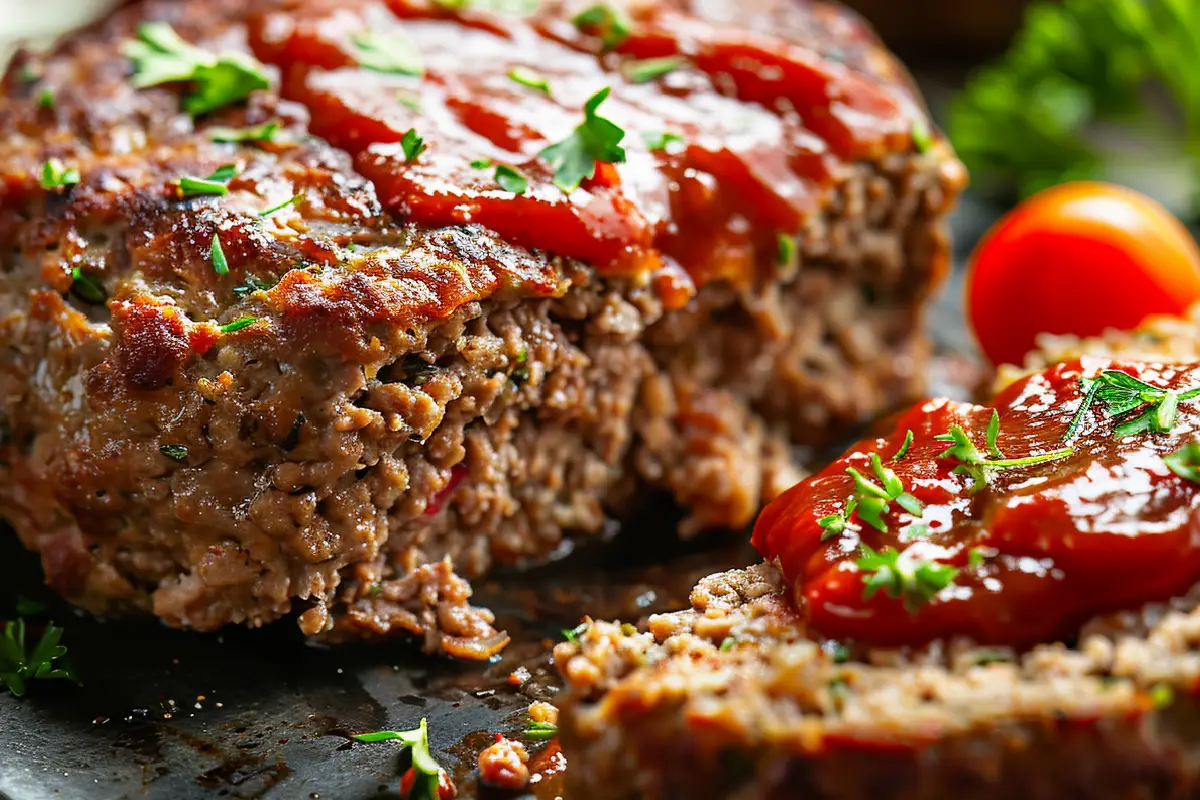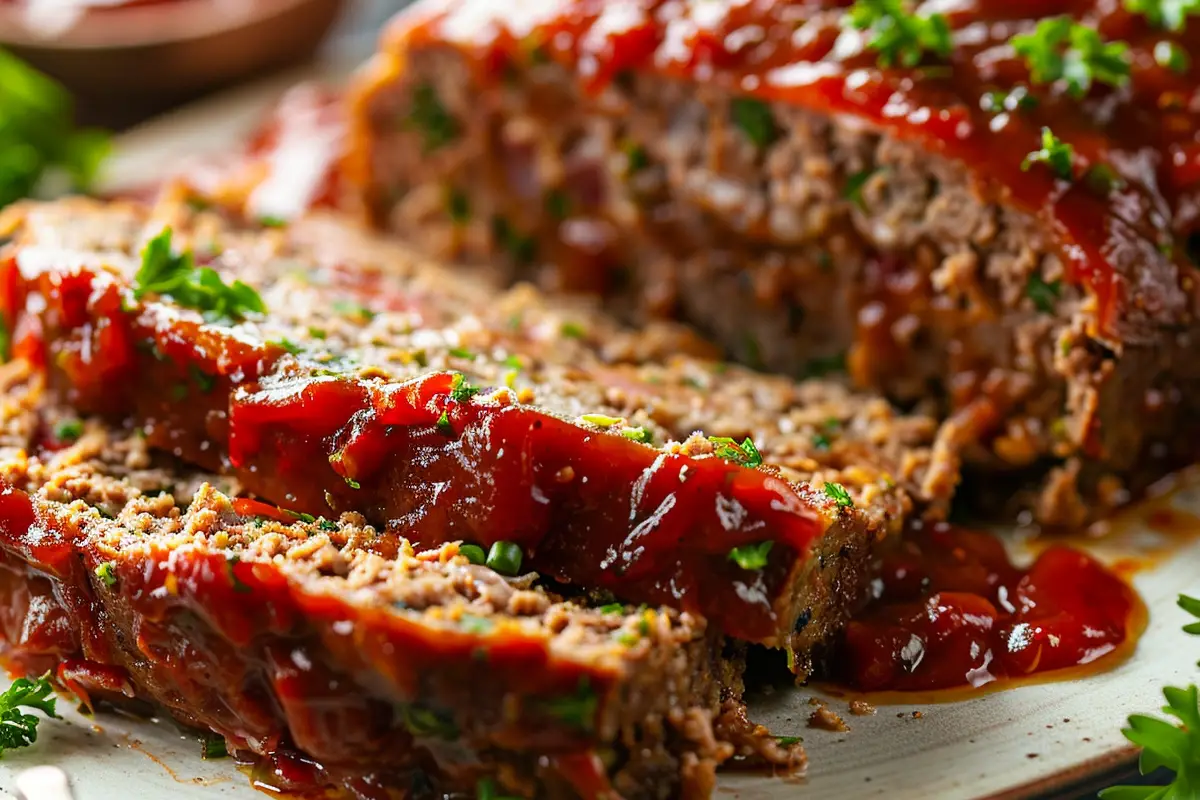Introduction to What Keeps Meatloaf from Falling Apart?
Meatloaf is a staple comfort food, loved for its savory flavor, versatility, and satisfying texture. However, it can be frustrating when your meatloaf falls apart when you try to serve it. Understanding what keeps meatloaf from falling apart is key to achieving the perfect slice. Whether you’re a novice cook or an experienced chef, these tips will help you create a meatloaf that holds together beautifully, delivering the perfect bite every time. So let’s discover What Keeps Meatloaf from Falling Apart.
Common Reasons Why Meatloaf Falls Apart
There are several factors that contribute to a meatloaf’s structural integrity. Here are the main reasons why your meatloaf might not be holding together:
- Lack of Binders (Eggs, Breadcrumbs, etc.): Binders like eggs and breadcrumbs are crucial for holding your meatloaf together. Without enough of these, your meatloaf may lack the necessary structure to stay intact. Binders work by soaking up moisture and holding the meat proteins together, creating a cohesive mass. Learn about different binders in this smoked meatloaf recipe, which uses a variety of ingredients to maintain the meatloaf’s shape and flavor.
- Overmixing the Ingredients: Overmixing can break down the meat fibers and result in a tough, crumbly texture. When you overmix, you’re essentially squeezing the moisture out of the meat, which leaves it dry and prone to crumbling. Mix the ingredients gently and only until combined to avoid this issue. Using your hands is often the best approach, as it allows you to feel when the mixture is just right.
- Excess Moisture in Ingredients: Vegetables like onions, peppers, and mushrooms can add excess moisture, which destabilizes the loaf. To reduce this, pre-cook the vegetables before adding them to your meat mixture. The pre-cooking process helps reduce water content, ensuring that the added moisture doesn’t interfere with the loaf’s structure. You can see how moisture is managed in other dishes like cheesy mashed potatoes, where balance is key to maintaining the desired texture.
Additional Causes of Meatloaf Falling Apart

Beyond the primary causes, there are a few more nuanced factors that can impact your meatloaf’s consistency:
- Incorrect Fat Content in the Meat: The fat content of your meat plays a significant role in how well your meatloaf holds together. Using meat that is too lean can lead to a dry loaf that crumbles easily. Ideally, you want a fat content of around 15-20%. Ground chuck (80/20) is a great choice, as it has enough fat to keep the meatloaf moist but not so much that it becomes greasy. A mix of lean meat and a slightly fattier cut, like ground pork, provides the ideal texture and flavor.
- Insufficient Rest Time After Baking: Resting meatloaf is just as crucial as resting a steak. The resting period allows the loaf to firm up, making it easier to slice without falling apart. Cutting into a meatloaf right out of the oven can cause it to break apart because the internal structure hasn’t settled. For best results, let your meatloaf rest for at least 10-15 minutes under a tent of foil to retain heat while it sets.
- Improper Pan Size or Shape: The shape of your meatloaf can also affect its structural integrity. If your meatloaf is too flat or spread out, it may not cook evenly, leading to weak spots where the meat crumbles. Using a loaf pan helps create a uniform shape, but free-forming the meatloaf on a baking sheet can also work if you shape it correctly, ensuring even cooking and a sturdy structure.
The Role of Binders: The Glue That Holds Meatloaf Together
Binders play a vital role in the success of your meatloaf, helping to keep everything in place during cooking and slicing. Without them, you may end up with a pile of crumbles instead of a firm, sliceable loaf.
- Eggs: Eggs are the most common binder used in meatloaf. They add moisture and help the meat, breadcrumbs, and other ingredients stick together. The protein in eggs coagulates during cooking, forming a stable structure that holds the loaf in place. If you’re making a larger meatloaf, consider adding an extra egg for added stability.
- Breadcrumbs, Crackers, and Alternatives: These dry fillers soak up moisture and create a stable structure. Breadcrumbs add a bit of texture and help distribute moisture evenly throughout the meatloaf. If you don’t have breadcrumbs on hand, crushed crackers, panko, or even day-old bread can serve the same purpose. For those avoiding gluten, gluten-free breadcrumbs or finely ground oats can work well. Adding seasoned breadcrumbs can also enhance the overall flavor of your meatloaf.
- Alternative Binders (Oatmeal, Rice, Gluten-Free Options): If you need to avoid traditional binders, alternatives like oats, rice, or chia seeds can provide a similar effect without compromising dietary requirements. These options not only bind the meatloaf but also add a unique texture and nutritional benefits. Oats, in particular, add fiber and can absorb moisture without altering the taste significantly.
Tips for Choosing the Right Binder
Choosing the right binder is essential based on dietary needs and texture preferences. If you’re looking for a binder that adds minimal flavor but maximum hold, traditional breadcrumbs or panko are ideal. For a heartier texture, oatmeal works wonders. If you’re aiming for a low-carb or keto-friendly meatloaf, almond flour or crushed pork rinds can provide binding power without the carbs. Always consider the overall balance of wet and dry ingredients when choosing your binder.
Tips to Prevent Meatloaf from Falling Apart
Perfecting your meatloaf is as much about technique as it is about the right ingredients. Here are some tips to ensure your meatloaf stays together:
- Proper Mixing Techniques: Mix your ingredients gently to avoid overworking the meat, which can lead to a dense loaf that falls apart easily. A light touch ensures that the meat fibers remain intact, providing a tender yet cohesive texture. Using a wooden spoon or your hands helps prevent overmixing, giving you better control over the consistency.
- Optimal Ratios of Meat to Binders: A good starting point is to use one egg and half a cup of breadcrumbs per pound of meat. This balance helps maintain the loaf’s structure without making it too dry or too wet. If you’re using a mix of meats, such as beef and pork, adjust the binders accordingly to account for the extra fat content. Experiment with ratios to find the perfect texture that suits your taste.
- Pre-Cooking Vegetables: Vegetables add flavor and moisture, but too much can make the meatloaf fall apart. Cooking vegetables before adding them helps remove excess water. For example, sautéing onions, peppers, or mushrooms until soft reduces the moisture content and enhances their flavor. Roasting vegetables can also intensify their sweetness, adding a rich dimension to your meatloaf.
- Cooling and Resting the Meatloaf Before Slicing: After removing the meatloaf from the oven, let it rest for 10-15 minutes. Resting allows the loaf to set and makes it easier to slice without crumbling. This step is crucial, as it helps the juices redistribute throughout the meat, enhancing both texture and taste. To keep the meatloaf warm, cover it loosely with foil during the resting period.
Additional Tips for a Perfect Meatloaf Texture
- Use a Loaf Pan or Free-Form on a Baking Sheet: While using a loaf pan helps shape the meatloaf, free-forming it on a baking sheet allows excess fat to drain away, preventing the loaf from becoming too greasy. Whichever method you choose, line your pan with parchment paper or lightly grease it to make removal easy. Free-form meatloaves also develop a crustier exterior, adding texture to each bite.
- Top with a Sauce or Glaze Sparingly: A sweet glaze or savory sauce enhances meatloaf’s flavor, but applying too much can make the surface soggy and unstable. Brush on just enough to create a thin, glossy layer that adds flavor without compromising the texture. Classic options include ketchup, BBQ sauce, or a mixture of tomato paste and brown sugar. For a unique twist, try a balsamic glaze or a spicy chipotle topping.
Expert Tips for the Perfect Meatloaf

Creating the perfect meatloaf involves more than just preventing it from falling apart. These tips can help elevate your meatloaf to the next level:
- Selecting the Right Meat Blend (Beef, Pork, Turkey): Using a combination of meats, such as beef and pork, can add depth of flavor and improve the loaf’s texture. However, be mindful that lean meats like turkey may require additional fat or binders to maintain moisture and structure. Experiment with different blends to find the perfect balance of flavor and stability. A classic blend is 50% beef, 25% pork, and 25% veal, which yields a juicy and tender meatloaf.
- Using Tomato Paste or Other Sauces Sparingly: Tomato paste adds flavor and moisture but should be used in moderation to prevent the meatloaf from becoming too wet and falling apart. If you love a saucy meatloaf, consider using sun-dried tomatoes or a thick tomato jam instead, which offer concentrated flavor without excess liquid. You can also mix a small amount of tomato paste directly into the meat mixture for an extra depth of flavor.
- Adding Cheese or Other Unique Ingredients: Cheese or other flavorful additions can enhance your meatloaf, but they can also alter the texture. Incorporate ingredients like feta, cheddar, or blue cheese sparingly, balancing them with sufficient binders to keep the meatloaf firm. For a Mediterranean twist, try adding olives, capers, or roasted red peppers for bursts of flavor.
Incorporating Unique Flavors Without Compromising Structure
Adding herbs, spices, and condiments is a great way to customize your meatloaf. Fresh herbs like parsley, thyme, or rosemary can elevate the flavor, while Worcestershire sauce, mustard, or even a bit of soy sauce can add depth and umami. Be careful not to add too much liquid when using wet ingredients, as they can impact the loaf’s stability. Dry spice blends like Italian seasoning, garlic powder, and smoked paprika can also add a rich layer of flavor without affecting the texture.
Troubleshooting Common Meatloaf Problems
Even with the right techniques, things can sometimes go wrong. Here’s how to fix common meatloaf issues:
- How to Fix a Mushy Meatloaf: If your meatloaf turns out mushy, it’s often due to too much liquid in the mixture. Add more breadcrumbs or another egg to absorb the moisture and help bind the loaf. You can also try placing the loaf back in the oven for a few minutes without a pan to firm it up. If the meatloaf remains too soft, serving it with a sturdy, toasted slice of bread can help hold it together when plated.
- Dealing with Dry Meatloaf: A dry meatloaf usually results from overcooking or using very lean meat. Adding a small amount of fat, such as butter or olive oil, can help improve moisture levels. Additionally, consider covering the meatloaf with foil while it cooks to retain moisture. You can also serve dry meatloaf with a rich gravy or sauce to add moisture back to each bite.
- What to Do if Meatloaf Crumbles When Slicing: Ensure that you let the meatloaf rest adequately before slicing. Resting allows the meat to firm up, making it less likely to crumble when cut. If your meatloaf still crumbles, consider using a sharper knife or a serrated knife, which can make cleaner cuts without tearing the loaf. For added stability, refrigerate the meatloaf for 20 minutes after resting to firm it up further before slicing.
FAQs about What Keeps Meatloaf from Falling Apart?
- Why does my meatloaf fall apart when I cut it?
- A lack of adequate binders or too much moisture in the ingredients can cause your meatloaf to fall apart. Ensuring the right balance of ingredients and proper resting time is key.
- Can I use oats instead of breadcrumbs?
- Yes, oats are an excellent alternative to breadcrumbs and add a slightly different texture to the meatloaf. They also provide additional fiber, making the meatloaf healthier.
- What’s the best binder for gluten-free meatloaf?
- Gluten-free breadcrumbs, oats, or crushed rice crackers are great binders for gluten-free versions of meatloaf. You can also use ground flaxseed or chia seeds mixed with water as a natural binder.
- How long should meatloaf rest before slicing?
- Allow the meatloaf to rest for at least 10-15 minutes to help it set properly. Resting helps lock in the juices and makes slicing easier.
- Can I make meatloaf without eggs?
- Yes, you can substitute eggs with ingredients like flaxseed meal, chia seeds, or commercial egg replacers. These alternatives provide similar binding properties without the use of eggs.
Conclusion and Tips on What Keeps Meatloaf from Falling Apart?

Crafting the perfect meatloaf involves a combination of the right binders, proper mixing techniques, and allowing the loaf to rest before slicing. By following these tips and avoiding common mistakes, you can enjoy a meatloaf that is not only delicious but also holds together perfectly every time. Whether you’re tweaking your favorite recipe or trying new techniques, these insights will help you achieve a meatloaf that’s firm, flavorful, and satisfying.
For more meatloaf inspiration, check out this smoked meatloaf recipe that delivers on both flavor and structure! And if you want to explore additional comfort food classics, don’t miss our guide on making cheesy mashed potatoes for a perfect side dish.

